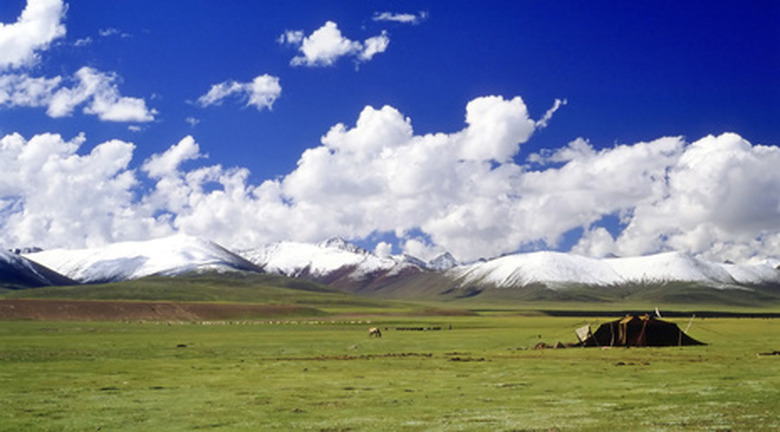What Plants Live In The Grasslands?
Grasslands consist of a variety of plants including tall grasses and short grasses. Trees also dot grasslands although they tend to grow close to streams and creeks. Once the rains start, grassland flowers start to bloom, turning the prairies, savannas and meadows into a carpet of wildflowers. A variety of wildlife and birds rely on these plants for food, nesting and shelter, making the grasslands a highly-valuable resource.
Buffalo Grass (Bouteloua dactyloides)
A warm-season perennial short grass, buffalo grass grows on the grasslands of the Great Plains. Growing to just 6 inches in height, the bluish-green colored grass turns yellow when dormant in the winter. The drought-tolerant grass prefers rich, well-drained clay and loam soil. Buffalo grass cannot tolerate shade and requires full sun to thrive. The grass spreads through runners that form a thick, almost impenetrable turf in the grasslands.
- Grasslands consist of a variety of plants including tall grasses and short grasses.
- A warm-season perennial short grass, buffalo grass grows on the grasslands of the Great Plains.
Big Bluestem (Andropogon gerardii)
A native of tall-grass habitat, big bluestem grass grows in arid conditions where nutrients and water tend to be scarce. This helps keep the grass upright rather than dropping over. Growing up to 80 inches in height, big bluestem flowers in August through September.
Queen Anne's Lace (Daucus carota)
Also referred to as wild carrot, Queen Anne's lace resembles a carrot plant during its first year of growth in the grasslands. The next year, the plant produces beautiful clumps of flat white flowers on the top of long stalks. While Queen Anne's lace comes from Europe, it quickly took hold of and grows in tall grass meadows. The 3-foot plant flowers in May to October. Butterflies find the perennial flower provides a great food resource.
- A native of tall-grass habitat, big bluestem grass grows in arid conditions where nutrients and water tend to be scarce.
- Also referred to as wild carrot, Queen Anne's lace resembles a carrot plant during its first year of growth in the grasslands.
Joe-Pye Weed (Eupatorium purpureum)
The fragrant scent of Joe-pye weed fills the air when the plant blooms between July and September in the grasslands. The perennial grows up to 7 feet in height with pale pink to purple flowers in large clusters. Joe-pye primarily grows near streams and savannas, preferring moist, loamy, well-drained soil in full sun to partial shade.
Lupines (Lupinus perennis)
Also known as bluebonnet, lupines primarily grows near trees found along streams in the grasslands. The plants grow up to 4 feet in height with spikes of beautiful white to purplish-blue flowers blooming on top in early to mid-summer. Each spring, the perennial plant grows from the same roots, creating a growing clump of plants that get bigger each year. Cattle ranging in the grasslands need to avoid lupine as all of its parts remain poisonous.
- The fragrant scent of Joe-pye weed fills the air when the plant blooms between July and September in the grasslands.
- Cattle ranging in the grasslands need to avoid lupine as all of its parts remain poisonous.
Grey-headed Coneflowers (Ratibida pinnata)
A native of the North American plains grasslands, grey-headed coneflower grows up to 4 feet in height with yellow or orange flowers appearing in the summer. The perennial plant thrives in fast-draining sandy or loamy soil. The plant also prefers sunny locations. Coneflower blooms in the second year of growth, returning each spring from the same roots with the plants forming expanding clumps.
